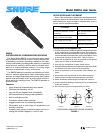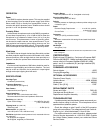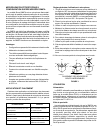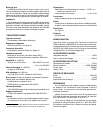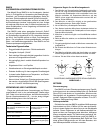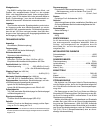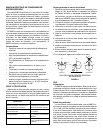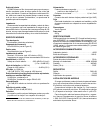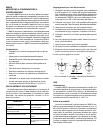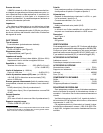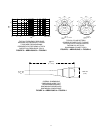
2
OPERATION
Power
The SM87A requires phantom power. This may be supplied
to the microphone from an external power supply (such as the
Shure model PS1A) or directly from preamplifiers, mixers, or
consoles with built-in phantom power. Suitable sources should
provide 11 to 52 Vdc phantom voltage.
Proximity Effect
Unidirectional microphones such as the SM87A progressive-
ly boost bass frequencies by 10 to 15 dB at 100 Hz when the
microphone is at a distance of about 6 mm (1/4 in.) from the
sound source. This phenomenon, known as proximity effect,
can be used to create a warmer, more powerful sound. To pre-
vent explosive low frequency sound during close-up use, the
SM87A bass response gradually rolls off. This provides greater
control and helps the user take advantage of proximity effect.
Wind Noise
The SM87A has an integral wind and pop filter which provides
excellent protection against most wind and breath noise. Under
adverse conditions, such as high winds or close proximity to a
“problem” vocalist, the optional foam windscreen can be used.
Impedance
A minimum load impedance of 800 ohms should be used for
maximum signal handling and minimum distortion. The load
may be as low as 150 ohms, but a reduction in output signal
strength and output clipping level will result.
SPECIFICATIONS
Cartridge Type
Condenser (electret bias)
Frequency Response
50 to 20,000 Hz (see Figure 2)
Polar Pattern
Supercardioid (see Figure 3)
Output Impedance
Rated at 150 ohms (100 ohms actual ±20%)
Recommended minimum load impedance: 800 ohms
Sensitivity (at 1,000 Hz)
Open Circuit Voltage –52.5 dBV/Pa (2.4 mV). . . . . . . . . . . . . . .
(1 Pa = 94 dB SPL)
Clipping Level (at 1,000 Hz)
1000 ohm Load –6 dBV (0.5 V). . . . . . . . . . . . . . . . . . . . . . . . . .
Maximum SPL (at 1,000 Hz)
140.5 dB (0.25% THD, 1000 ohm load)
Self-Noise (equivalent sound pressure level; measured with true
rms voltmeter)
24 dB typical, A-weighted
26 dB typical, weighted per DIN 45 405
Dynamic Range
116.5 dB (maximum SPL to A-weighted noise level)
Signal-to-Noise Ratio
70 dB at 94 dB SPL (IEC 651)*
Polarity
Positive pressure on diaphragm produces positive voltage on pin
2 relative to pin 3
Power
Phantom Supply Requirement 11 to 52 Vdc, positive . . . . . . . .
at both pins 2 and 3
Current Drain 1.0 to 1.2 mA. . . . . . . . . . . . . . . . . . . . . . . . . . . . .
Connector
Three–pin (XLR) professional audio
Case
Aluminum construction with steel grille and satin black finish
Dimensions
See Figure 4
Net Weight
200 grams (7 oz)
*S/N ratio is difference between 94 dB SPL and equivalent SPL of self–
noise A-weighted.
CERTIFICATION
Eligible to bear CE Marking. Conforms to European EMC
Directive 89/336/EEC. Meets applicable tests and perfor-
mance criteria in European Standard EN55103 (1996)
parts 1 and 2, for residential (E1) and light industrial (E2)
environments.
FURNISHED ACCESSORIES
Swivel Adapter A25D. . . . . . . . . . . . . . . . . . . . . . . . . . . . . . . .
Carrying/Storage Bag 26A13. . . . . . . . . . . . . . . . . . . . . . . . .
OPTIONAL ACCESSORIES
Phantom Power Supply PS1A. . . . . . . . . . . . . . . . . . . . . . . .
Isolation Mount A55M, A55HM. . . . . . . . . . . . . . . . . . . . . . . .
Windscreen A85WS. . . . . . . . . . . . . . . . . . . . . . . . . . . . . . . . .
Cable (7.6 m [25 ft]) C25F. . . . . . . . . . . . . . . . . . . . . . . . . . . .
REPLACEMENT PARTS
Screen and Grille RK214G. . . . . . . . . . . . . . . . . . . . . . . . . . .
Cartridge and Shock Mount R128. . . . . . . . . . . . . . . . . . . . .
Replacement Amplifier Assembly RK356. . . . . . . . . . . . . . .
TROUBLESHOOTING
If problems arise, test the phantom power source and con-
nectors before calling for service. The microphone will not
operate without phantom power.
Check the voltage on pins 2 and 3 of the XLR connector
going to the microphone. The voltage at pins 2 and 3 with ref-
erence to pin 1 should be between 11 and 48 Vdc.
For additional service or parts information, please contact
Shure’s Service department at 1–800–516–2525. Outside
the United States, please contact your authorized Shure
Service Center.



